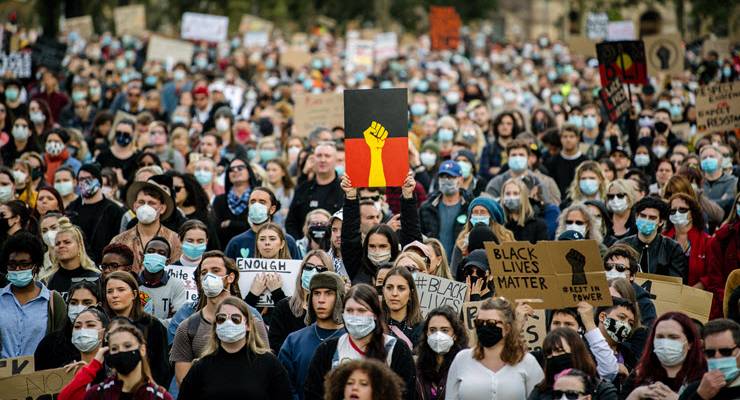
For the last three months, Australians have been lab rats. Since the coronavirus hit our shores, we’ve become unwitting participants in a perverse social and scientific experiment that would probably never get ethics approval.
By closely monitoring these population-wide experiments, we’ve learned an awful lot. We know that social distancing, avoiding gatherings, spending months in dismal hibernation is probably the most effective way to keep the virus under control.
We’ve also learned a lot about who we are as a country. In Australia, the Ned Kelly myth has been shattered by two months of well-behaved, narc-ish compliance with one of the strictest, most heavily-policed lockdowns in the western world. It’s a sharp contrast to the United States, where protesters took up arms to demand the right to get a haircut.
That orderliness slipped a little in the last week. When four Minneapolis police officers choked George Floyd to death over a $20 bill, it lit a fuse under long-simmering issues of racial injustice and police brutality we constantly brush aside at home.
And as thousands took to the streets in defiance of scolding politicians and health officials, it represented a turning point, the beginning of the end of our collective, laser-like focus on COVID-19.
Those rallies will be the latest experiment for our coronavirus lab. Will a genuine and important protest lead to an outbreak of cases, and if it does, where does the fault lie? Can we, as a society, balance our focus on the pandemic with tackling the kind of racism that has stained Australia for centuries?
How do we do the right thing?
While politicians have spent much of the last week attacking Black Lives Matter (BLM) protesters, health experts have been far more muted.
“The short answer is, we don’t know what the impact will be,” says Australian National University infectious diseases expert Peter Collignon.
Collingon says while there is still some low-level community transmission, the virus is less likely to spread outdoors.
Norman Swan, the ABC science journalist and doctor who’s become one of the most well-trusted, if risk-averse, voices during the pandemic, said the risk of transmitting the virus was “low-ish but not completely absent”.
National Aboriginal Community Controlled Health Organisation chief executive Pat Turner called for vigilance, urging people who attended to follow social distancing and hand hygiene.
“It has been recognised that COVID-19 poses a serious risk to Aboriginal and Torres Strait Islander people due to higher levels of chronic conditions especially those aged 50 years and older,” Turner told Crikey.
The reality is that while gatherings do pose a risk, our virus numbers have been low for weeks. In New South Wales, there hasn’t been a confirmed case of community transmission in 15 days.
Still, it’s undeniable that the protests have caused many progressives who have been highly risk averse about the virus to change their tune slightly earlier than expected. And yesterday, a Melbourne man who’d been at the protests tested positive for COVID-19.
Paul Griffin, director of infectious diseases at Brisbane’s Mater Health Services, felt the challenge wasn’t necessarily the protest but the optics — seeing thousands gathering could make it harder for authorities to control the message about the pandemic risks.
“The greatest risk is the perception and confusion around what other restrictions are now required,” Griffin says.
“I think the risk of that confusion is disengagement and loss of trust in the health system.”
The response to the protests have been a study in confusion and whatabouttery. Many on the right are furious the protests went ahead after Anzac Day was cancelled. Supporters point to calls to return to work and travel, the opening of schools as mass gatherings that are fine with politicians.
Fear of a black protest
But if last weekend’s protests were another test, it was one Australia’s largely white political class failed. UNSW epidemiologist Mary-Louise McLaws sees the protests not as a risk, but a failure by police to listen to the hearts and minds of black Australia.
“The authorities sadly put a premature stop to a conversation that could’ve produced a safe rally. For the authorities not to appreciate that [racism] is a serious public health issue for Indigenous Australians can only come from a position of privilege.”
McLaws, who worked on the response to SARS said that with greater compliance, police could have helped a safe protest happen — handing out masks and hand sanitiser, working with organisers to avoid shouting which can spread viral droplets. She also points out that anti-Beijing protests in Hong Kong last month did not cause a large outbreak.
Instead, NSW Police went to court to try (unsuccessfully) to get last weekend’s protests banned. They’ve succeeded in getting more protests, planned for the weekend, banned, and are promising to make arrests. Since last week, politicians have used the virus as an excuse to attack protesters, rather than engage substantively with what the BLM movement is about.
Scott Morrison’s attacks on the protesters, largely made over talkback radio, have ratcheted up over the last week, until yesterday, he was suggesting to 3AW’s Neil Mitchell that they “should be charged”. This morning, Finance Minister Mathias Cormann suggested protesters could lose JobSeeker payments.
Unlike the United States, where the protests have caused a profound shift in the discourse around systemic racism and police brutality, here it seems like the coronavirus is being used as a convenient excuse to stay in the comfortable terrain of historical amnesia.
Notably, in the United States, numerous health experts have come out in support of protests. COVID-19 kills, so does systemic racism. Here, the Public Health Association of Australia called for protests to go ahead, with CEO Terry Slevin pointing out that the pandemic and Black Lives Matter should not be framed as competing health objectives.
The protests expose the limits of a blinkered approach to the pandemic that prioritises the virus above all else, one which can overlook the public health impacts of centuries of racial injustice.
Coronavirus might have turned Australia into a large laboratory. But an experiment that ignores the health inequities between black and white Australia isn’t going to yield very useful, or just, results.








“Norman Swan, the ABC science journalist and doctor” – he’s registered as a doctor but as far as I can tell hasn’t practiced for decades. And since then until recently he didn’t call himself a doctor.
Maybe, but as presenter of The Health Report, he’s kept himself better informed on current medicine than many GPs, I’ll bet.
And that’s no measure.
As informed as virolgists and epidemiologists is.
In which case you’d be a scholar not a journalist.
I stopped listening to him when I hesrd him opine about face masks in preventing transmission via aerosols. He was clueless. Hadn’t had time to swot up probably.
His last gig as a doctor was measuring fat content on biggest loser.
I can see the emerging narrative about the “man at the protest”: He was at the protest. He had CV-19. Other people were at the protest. They have CV-19. Therefore the protests caused the spread.
In the words of that great student of classical logic, Admiral Ackbar: “Its a trap!”
Ascribing infection causation to one specific even in the context of a whole pandemic is just not possible. But we can just see what will happen – any uptick in infection rate in the next two weeks will be the “fault” of the protesters (who were also presumably not doing anything else that could cause infection like shopping, dropping the kids at school, going to the re-opened cafes, traveling on public transport etc. etc. etc.)
Or as Admiral Akbar may also have put it (less pithily): “Its illogical but politically useful bulls–t.”
If you went to shopping centres this week, there is a fair chance you can’t socially space properly. If we head into another spike, the protests will be blamed – and in an odd indirect way it may be true, I think that a lot of people have decided that if those protests could go ahead, there is no need to socially distance, and thus people stop spacing themselves prematurely. That may lead to more community transmission, but not directly from the protests.
I am in a regional area that has had no person to person transmission – but while there were not a lot of masks used here, the number has now substantially fallen even though the spacing has also been reduced. Thus we are more likely to see spikes for those reasons. If we don’t, we may be able to open back up quicker, which may also turn out to be an advantage of the protests.
Dead right, social distancing stopped last week, and a lot of people (quite rightly) are citing the BLM protests…
Myself and three others looked around our inner eastern suburbs (Sydney) shopping strip for an uncrowded restaurant last night, but gave up. They were all full, just like any other busy Friday night. Just before returning home hungry, we spotted a spare table squeezed in a packed room and asked if we could use it. “Of course!” said the waiter without hesitation – presumably having his first shift in over three months… No one was doing anything differently, and we passed around the shared menu and shouted at each other over the usual din… “Are we still social distancing?” my partner asked. “Not since last weekend!” explained one of my companions… “That’s all over now.” And he was someone who had been intensely risk-averse – having spent quite a bit of the last few months scolding others for their transgressions.
There will be a “second wave” if the Norman Swans and all the disease experts who have guided our government’s policies are right – and I have no doubt they are. But there won’t be another economic lockdown. Who would dare now?
At the Brisbane rally, last Saturday the cops [well Police Liaison Officers (PLOs)] were handing out masks and squirting sanitiser.
Once in awhile, the QPS seems to get things right.
There has been no need for any of this, they are carrying on as if the virus is a miasma waiting to pounce, it’s spread only by contact with someone who has it. Honestly, how can people be so dumb.
Marilyn,
The highest contagion on this virus is believed, at this point, to be just before the symptoms start to show, while it is now believed those who are entirely asymptomatic cause very little spread. Thus if you have “contact with someone who has it” just before they have any symptoms you won’t actually know that you have done so (and contact can be touching the same surfaces, or if very unlucky walking through an area where droplets are still hanging in the air).
The only experiment here is in measuring how great the level of double standards are for the Libs and their supporters, and what the hell else they will jump on under the name of CV-19 safety.
I think it’s interesting and perhaps significant that a widespread anti-racism protest movement happened right on the back of one of the most unifying global threats that we’ve ever seen.
There have been variations in available health care and susceptibility at various places around the world, but we’ve all been at risk of the same illness and, by and large, the containment strategy has been pretty much the same, everywhere. With the exception of a few countries like Sweden, we’ve all been in lock down for a couple of months. As we’ve been told repeatedly, we’re all in this together.
Then we all see on video a defenceless black man murdered by a police officer and, lo and behold, we’re still all in this together.